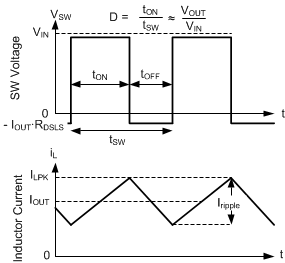SNVSCI9A June 2024 – September 2024 LMR36503E-Q1
PRODUCTION DATA
- 1
- 1 Features
- 2 Applications
- 3 Description
- 4 Device Comparison Table
- 5 Pin Configuration and Functions
- 6 Specifications
-
7 Detailed Description
- 7.1 Overview
- 7.2 Functional Block Diagram
- 7.3
Feature Description
- 7.3.1 Enable, Start-Up, and Shutdown
- 7.3.2 External CLK SYNC (with MODE/SYNC)
- 7.3.3 Adjustable Switching Frequency (with RT)
- 7.3.4 Power-Good Output Operation
- 7.3.5 Internal LDO, VCC UVLO, and VOUT/BIAS Input
- 7.3.6 Bootstrap Voltage and VCBOOT-UVLO (CBOOT Terminal)
- 7.3.7 Output Voltage Selection
- 7.3.8 Soft Start and Recovery from Dropout
- 7.3.9 Current Limit and Short Circuit
- 7.3.10 Thermal Shutdown
- 7.3.11 Input Supply Current
- 7.4 Device Functional Modes
-
8 Application and Implementation
- 8.1 Application Information
- 8.2
Typical Application
- 8.2.1 Design Requirements
- 8.2.2 Detailed Design Procedure
- 8.2.3 Application Curves
- 8.3 Best Design Practices
- 8.4 Power Supply Recommendations
- 8.5 Layout
- 9 Device and Documentation Support
- 10Revision History
- 11Mechanical, Packaging, and Orderable Information
7.4.3.1 CCM Mode
The following operating description of the LMR36503E-Q1 refers to the Section 7.2 and to the waveforms in Figure 7-17. In CCM, the LMR36503E-Q1 supplies a regulated output voltage by turning on the internal high-side (HS) and low-side (LS) switches with varying duty cycle (D). During the HS switch on-time, the SW pin voltage, VSW, swings up to approximately VIN, and the inductor current, iL, increases with a linear slope. The HS switch is turned off by the control logic. During the HS switch off-time, tOFF, the LS switch is turned on. Inductor current discharges through the LS switch, which forces the VSW to swing below ground by the voltage drop across the LS switch. The converter loop adjusts the duty cycle to maintain a constant output voltage. D is defined by the on-time of the HS switch over the switching period:
In an ideal buck converter where losses are ignored, D is proportional to the output voltage and inversely proportional to the input voltage:
 Figure 7-17 SW Voltage and Inductor Current Waveforms in Continuous Conduction Mode (CCM)
Figure 7-17 SW Voltage and Inductor Current Waveforms in Continuous Conduction Mode (CCM)